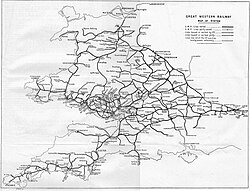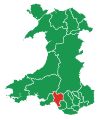Cardiff-Bridgend Railway
Much of the South Wales Main Line was built between the 1830s and 1886; originally trains to and from destinations in England ran via Chepstow, Gloucester and Stroud, joining the Great Western Main Line at Swindon. A more direct route was challenging yet desirable, leading to the construction of the line's most prominent civil engineering features, the Severn Tunnel. Completed in 1886, it permitted a significant reduction in journey times between various destinations, especially after the construction of the Badminton Line in 1903. During the British Rail era, the line was incorporated into the Western Region and steam locomotives were replaced by diesel locomotives, such as the Intercity 125 high speed trainsets. During the 2010s, the line between Swindon and Cardiff Central was electrified using the 25 kV AC overhead system as part of the wider electrification of the Great Western Main Line; this has permitted the operation of electric traction between Cardiff and London for the first time to commence in 2020.
Presently, Great Western Railway operates Class 800 trains between London and South Wales, and "Castle class" High Speed Trains on services between Cardiff and South West England. CrossCountry provides services from Cardiff to Nottingham via Severn Tunnel Junction and thence the Gloucester to Newport Line via Gloucester and Birmingham. Transport for Wales operates services between South Wales, and North Wales and the Midlands on the line. Operations are mostly managed from the Wales Rail Operating Centre in Cardiff; digital signalling is to be rolled out.
History
The South Wales Railway was built to carry traffic from Gloucester to the strategic port of Milford Haven and capture the lucrative transatlantic maritime trade as well as communication with Ireland. At Gloucester, the South Wales Railway met with the Great Western Railway (GWR) which formed a route between London and South Wales after the opening of Brunel's Chepstow Railway Bridge in 1852. The original route of the GWR left the Bristol-bound Great Western Main Line at Swindon, proceeding via Stroud, Gloucester and Chepstow before rejoining the present line at Severn Tunnel Junction; this circular route gave rise to the nickname 'Great Way Round'.
GWR officials realised that the journey time between the South Wales Main Line and the Great Western Main Line could be significantly shortened by the construction of a tunnel directly underneath the River Severn, which would be faster than the ferry service between Portskewett, Monmouthshire and New Passage, Gloucestershire. During the early 1870s, GWR's chief engineer, Sir John Hawkshaw, developed his design for what would become the Severn Tunnel and the company obtained an Act of Parliament on 27 June 1872 that authorised the construction of the tunnel. The tunnel's construction was time consuming and disrupted by water infiltration, yet proceeded nonetheless.
The completed tunnel was opened to regular goods trains during September 1886; the first passenger train followed on 1 December 1886. The opening of a more direct route to and from South Wales led to trains from Swindon to Newport and beyond being thereafter routed via Bath, Bristol and the tunnel.
The route used today was established in 1903 with the building of what is often known as the Badminton Line. This involved the construction of about 33 miles (53 km) of new track, and tunnels at Alderton and Sodbury. The new line left the Bath line beyond Swindon at what is now Royal Wootton Bassett, rejoining the earlier route north of Bristol near Patchway. Not only did this provide a more direct route for traffic to and from South Wales, the gradients were easier for coal trains to negotiate, and it was thought that the line would be a boost to what was, at the time of building, the expanding port of Fishguard. This was the GWR's connection with trans-Atlantic ocean liner departures.
During the British Rail era, the line was incorporated into the Western Region and steam locomotives were replaced by diesel locomotives. Perhaps the most significant change occurred in 1976 in the form of the Intercity 125, a new high speed train fleet that regularly ran at speeds of up to 125 mph (201 km/h) that was first introduced in the Western Region]]. The Intercity 125 would remain in use into the twenty-first century and marked a considerable improvement in service.
In 2005, the Strategic Rail Authority produced a Route Utilisation Strategy for the Great Western Main Line in 2005 to propose ways of meeting increased traffic levels. Network Rail's 2007 Business Plan included the provision of extra platform capacity at Cardiff Central, Newport and Bristol Parkway, together with resignalling and line speed improvements in South Wales, most of which would be delivered in 2010–2014.
Electrification

The South Wales Main Line was one of the last of the major inter-city routes in Great Britain to remain un-electrified. In 2012, the British government announced it would proceed with work to electrify the South Wales Main Line as part of a wider scheme of electrification on the Great Western Main Line. The line from London to Cardiff was fully electrified by Christmas 2019, the first electric trains began operating through the Severn Tunnel in June 2020.
The Hitachi Super Express trains bought for Great Western inter-city services are predominantly electric units, but a portion of the fleet are dual power source electro-diesel bi-mode trains, which enabled services to operate before line electrification is complete. The bi-mode trains will allow inter-city services to continue to operate from London all the way to Carmarthen in the future. The Super Express trains were expected to bring an estimated 15% increase in capacity during the morning peak hours. Electrification cut journey times between Swansea and London by an estimated 20 minutes, although electrification will not extend west of Cardiff to Swansea, Carmarthen or Pembroke Dock, and services on the line to Brighton, Portsmouth Harbour and Taunton will continue to be operated by diesel trains, as the Bristol to Exeter Line and the Wessex Main Line will not be electrified.
Infrastructure

There are four tracks from Severn Tunnel Junction through Newport to Cardiff Central, with two tracks on the remaining sections. Multiple-aspect signals are controlled from several power signal boxes including Swindon, Bristol and two in Cardiff. Over the August Bank Holiday weekend 2016, control of the signals between Westerleigh Junction and Pilning was switched over to the Thames Valley Signalling Centre. These signals now carry the prefix 'BL'.
The maximum line speed from Wootton Bassett Junction to Coalpit Heath is 125 mph (200 km/h); 90 mph (145 km/h) from Coalpit Heath to Newport; 90 mph (145 km/h) from Newport to east of Bridgend; 75 mph (120 km/h) from east of Bridgend to Swansea Loop North junction (with a small section of 100 mph (160 km/h) track through Pyle station); and 40 mph (65 km/h) from Swansea Loop North Junction to Swansea.
Associated routes
A diversionary route exists if the Severn Tunnel is closed. This takes trains from Severn Tunnel Junction to Gloucester, from where they can rejoin the main line either via the Golden Valley Line to Swindon, or take the Cross-Country Route and reverse at Bristol Parkway.
If the line is closed between Cardiff Central and Bridgend, an alternative route exists along the Vale of Glamorgan Line.
Half of peak High Speed Trains and most off peak trains continue from Cardiff Central to Swansea, with a few continuing to Carmarthen or in summer, Pembroke Dock.
The local service between Swansea and Cardiff is branded Swanline. The urban network within and surrounding Cardiff is referred to as the Valley Lines.
Communities served
|
|
Accidents and incidents
- On 7 March 2015, Battle of Britain-class locomotive 34067 Tangmere was hauling a charter train that overran a signal at Wooton Bassett, Wiltshire. The train's operator, West Coast Railway Company was temporarily banned from running trains on the British railway network as a direct consequence of this incident.
See also
References
Citations
- ^ MacDermot 1927, pp.556–558.
- ^ Ernie Shepherd, Fishguard and Rosslare Railways and Harbours Company: An Illustrated History, Colourpoint Books, Newtownards, 2015, ISBN 978-1-78073-067-7
- ^ MacDermot 1927, pp. 567, 569.
- ^ "South Wales Coastal" (PDF). Dovetail Games. Retrieved 2 October 2017.
- ^ "The Story of the G.W.R." Railway Wonders of the World. Retrieved 2 October 2017.
- ^ "Severn Tunnel". engineering-timelines.com. Archived from the original on 2 July 2018. Retrieved 2 July 2018.
- ^ Davis, R. H. (1955). Deep Diving and Submarine Operations (6th ed.). Tolworth, Surbiton, Surrey: Siebe Gorman & Company Ltd. p. 693.
- ^ Quick, D. (1970). "A History of Closed Circuit Oxygen Underwater Breathing Apparatus" (PDF). Royal Australian Navy, School of Underwater Medicine. RANSUM-1-70. Archived from the original on 24 September 2012. Retrieved 3 March 2009.
- ^ Wikisource:The Severn Tunnel/Chapter 11
- ^ Walker, Thomas A. (27 June 2013). The Severn Tunnel: Its Construction and Difficulties, 1872–1887. Cambridge University Press. ISBN 9781108063401. Retrieved 2 February 2015.
- ^ Robertson, Kevin; Abbott, David (1988). GWR The Badminton Line – A portrait of a railway. Sutton Publishing Ltd. ISBN 0-86299-459-4.
- ^ "New train speeds into service". BBC News. British Broadcasting Corporation. 4 October 1976. Retrieved 15 May 2019.
- ^ Owen, A.D.; Phillips, G.D.A. "The Characteristics of Railway passenger demand" (PDF). University of Bath. p. 234.
- ^ "New opportunities for the railways: the privatisation of British Rail" (PDF). Railway Archive. p. 8. Retrieved 18 May 2009.
- ^ "GWML electrification dates revealed". www.railtechnologymagazine.com. Retrieved 16 October 2017.
- ^ Dearman, Peter (28 April 2011). "Electrification: delivering the transformation". globalrailnews.com. Retrieved 10 March 2014.
- ^ Carr, Collin (13 December 2016). "Severn Tunnel Electrification - Planning logistics and interfaces". Rail Engineer. Archived from the original on 2 July 2018.
- ^ "Network Rail completes Great Western electrification". International Railway Journal. 5 June 2020.
- ^ "Britain's Transport Infrastructure, Rail Electrification" (PDF). Department for Transport. Archived from the original (PDF) on 23 January 2017. Retrieved 16 September 2013.
- ^ "Network Rail – Wales Route Utilisation Strategy (November 2008)" (PDF). Archived from the original (PDF) on 7 June 2011. Retrieved 16 September 2013.
- ^ "Western Route Sectional Appendix December 2021" (PDF). Network Rail. 4 September 2021. Retrieved 21 December 2021.
- ^ "Network Rail: Route specifications 2011" (PDF). Network Rail. Archived from the original (PDF) on 30 January 2015. Retrieved 22 March 2015.
Bibliography
- Network Rail Passenger Timetable. London, UK: Network Rail. 2006.
- MacDermot, E. T. (1927). History of the Great Western Railway, vol. I: 1833–1863. Paddington, UK: Great Western Railway.
External links
- 2007 Business Plan, Network Rail, London







